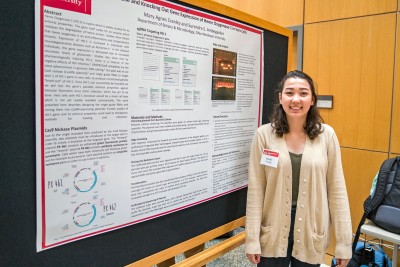Abstract
Cas9 Nickase and Knocking out Gene Expression of Heme Oxygenase-1 in Vero Cells
 Student: Mary Agnes Cranley
Student: Mary Agnes Cranley
Mentor: Suren Ambegaokar (OWU Department of Botany & Microbiology, Neuroscience Program)
The gene heme oxygenase-1 (HO-1) has the potential to be a key factor in the therapeutic treatments for viral infections such as HIV, Hepatitus C, and Ebola. The genome editing tool CRISPR/Cas9N is a revolutionary technology that we are employing to study if HO-1 can prevent infections of other viruses such as Vesicular Stomatitis Virus. This work will create a new tool that may help to lead to new medicines that can treat viral infections.
Heme Oxygenase-1 (HO-1) is a gene which is widely studied for its antiviral properties. Studies have shown that HO-1 is an anti-inflammatory and cytoprotective enzyme in response to several types of cellular injury such as oxidative stress, UV radiation, or heavy metal exposure. Expression of HO-1 is increased in individuals with neurodegenerative diseases such as Alzheimer's, and pharmacological induction of HO-1 results in reduced pathogenesis caused by HIV-1, in addition to other viruses. Vero cells, derived from Green Monkey kidney cells, are standard cell lines use in virological assays, including for the study of vesicular stomatitis virus (VSV). We hypothesize that HO-1 is protective against VSV infection in Vero cells, and that eliminating gene expression of HO-1 (or “knocking out” HO-1) will result in increased rates of VSV infection. To create this HO-1 knock-out in Vero cells, we are using the latest advancement in genome editing – the CRISPR/Cas9 Nickase system. The project will not only allow us to test if HO-1 can mitigate VSV infection, but will also make available to the scientific community a novel reagent to further investigate antiviral properties of HO-1, which may lead to therapeutic methods for treating viral infections.
